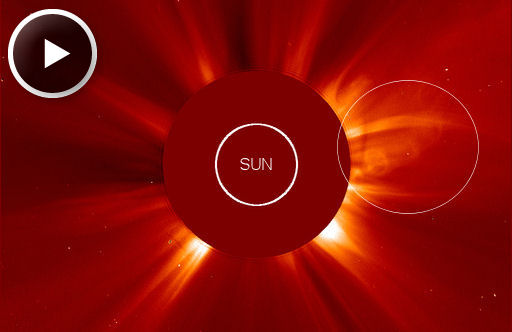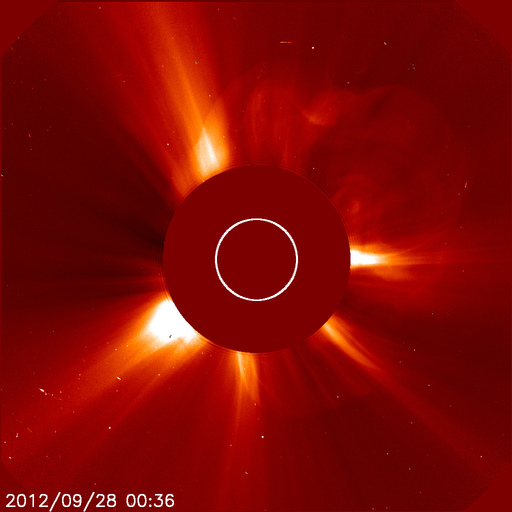It looks like you're using an Ad Blocker.
Please white-list or disable AboveTopSecret.com in your ad-blocking tool.
Thank you.
Some features of ATS will be disabled while you continue to use an ad-blocker.
5
share:
Hey guys, I've only been watching the solar imagery and data feeds for a year or so with any real close scrutiny. So, I've never seen this
before..... Can someone add anything in terms of what this might do if it wasn't pointing at Venus but pointing at Earth?
 (Source: Spaceweather.com) -The video is there to play as well.
(Source: Spaceweather.com) -The video is there to play as well.
This is currently running on Space Weather's front page. I'm also curious by what the piece refers to as the possibility of explosions in the upper atmosphere of Venus due to their lack of magnetic shielding the way Earth has. I seem to recall from school classes that Venus has a rather combustible atmosphere all around..... I wonder how bad this could get for it?
Sunspot 1583 is in a near-constant state of eruption. Magnetic instabilities in the sunspot's magnetic canopy are hurling massive "puffs" of magnetized plasma into space. The Solar and Heliospheric Observatory caught some of them emerging during the early hours of Oct. 2nd; click to set the scene in motion:

This is currently running on Space Weather's front page. I'm also curious by what the piece refers to as the possibility of explosions in the upper atmosphere of Venus due to their lack of magnetic shielding the way Earth has. I seem to recall from school classes that Venus has a rather combustible atmosphere all around..... I wonder how bad this could get for it?
Just a series of minor CMEs. If they were Earth directed they would do the same sort of stuff that minor CMEs always do.
The atmosphere of Venus is composed mostly of CO2, not exactly combustible. Hot flow anomalies occur frequently in Earth's magnetosphere but were somewhat unexpected when first observed on Venus.
The atmosphere of Venus is composed mostly of CO2, not exactly combustible. Hot flow anomalies occur frequently in Earth's magnetosphere but were somewhat unexpected when first observed on Venus.
reply to post by Phage
Okay, so the Plasma they're talking about and picturing isn't more physical and tangible than the low levels of energy we have passing across our own atmosphere all the time? The story there seemed to imply this had some mass to it?
I'd imagine it would at least be safe to bet energy dense enough to actually see visually would give our satellites a real bad day, right?
I guess I'm just surprised by the idea that the energy bands/waves/tendrils or whatever various forms are called that we all see around the sun can actually leave and travel any distance that way? It never occurred to me that we could get a CME we'd actually be able to see with our eyes on space imagery.
I'd note of course, the material linked from Space Weather makes very clear that damage to the atmosphere is because of the lack of a magnetic field around Venus. A problem we don't have here. I don't mean to suggest a similar thing could happen here. It's just quite a sight and reminder of the Sun's power.
Okay, so the Plasma they're talking about and picturing isn't more physical and tangible than the low levels of energy we have passing across our own atmosphere all the time? The story there seemed to imply this had some mass to it?
I'd imagine it would at least be safe to bet energy dense enough to actually see visually would give our satellites a real bad day, right?
I guess I'm just surprised by the idea that the energy bands/waves/tendrils or whatever various forms are called that we all see around the sun can actually leave and travel any distance that way? It never occurred to me that we could get a CME we'd actually be able to see with our eyes on space imagery.
I'd note of course, the material linked from Space Weather makes very clear that damage to the atmosphere is because of the lack of a magnetic field around Venus. A problem we don't have here. I don't mean to suggest a similar thing could happen here. It's just quite a sight and reminder of the Sun's power.
I thought I'd at this to the thread for some context. It's from the NASA site linked at Space Weather's article. This event sounds real interesting
both to me as a pure amateur and the professionals. Hmmm
Sounds like quite an event and not necessarily a nice one to be around for on those planets that lack a magnetic field to keep all that far away from the atmosphere. I noticed earlier in the article, it mentions Earth's magnetic field catches the majority of this 40,000 miles away. That's reassuring. I guess that also puts even the Geo-Sync satellites inside the majority of the protection. Well, the sun is full of great displays anyway. I'm glad that's all it generally ever is from where we sit.
Observing an HFA on Venus will help scientists tease out how space weather is similar and different at this planet so foreign to our own. With no magnetic field to interact with, space weather at Venus is milder than that at Earth, but occurs much closer to the surface.
"Hot flow anomalies average one a day near Earth," says Goddard scientist Glyn Collinson and the first author on the new paper. "They've been seen at Saturn, they may have been seen at Mars, and now we're seeing them at Venus. But at Venus, since there's no protective magnetic field, the explosion happens right above the surface of the planet."
Source
The bow shock on Venus serves as the boundary between the incoming solar wind, and the planet's own ionosphere – a layer of atmosphere filled with charged particles. This boundary changes in height easily in response to the environment, and so the scientists believe it would also respond strongly in the presence of an HFA. Since the HFA causes material to flow sunward, away from the planet, it may operate almost like a vacuum cleaner, pulling that bow shock further away from Venus. The size of the ionosphere would swell in concert.
Sounds like quite an event and not necessarily a nice one to be around for on those planets that lack a magnetic field to keep all that far away from the atmosphere. I noticed earlier in the article, it mentions Earth's magnetic field catches the majority of this 40,000 miles away. That's reassuring. I guess that also puts even the Geo-Sync satellites inside the majority of the protection. Well, the sun is full of great displays anyway. I'm glad that's all it generally ever is from where we sit.
reply to post by Wrabbit2000
That one of the main reasons for the coronograph images from SOHO and STEREO. Here's the CME that caused the geomagnetic storm yesterday:
From SOHO:
From STEREO B:
From STEREO A:
It never occurred to me that we could get a CME we'd actually be able to see with our eyes on space imagery.
That one of the main reasons for the coronograph images from SOHO and STEREO. Here's the CME that caused the geomagnetic storm yesterday:
From SOHO:
From STEREO B:
From STEREO A:
edit on 10/2/2012 by Phage because: (no reason given)
new topics
-
What is the white pill?
Philosophy and Metaphysics: 1 hours ago -
Mike Pinder The Moody Blues R.I.P.
Music: 2 hours ago -
Putin, Russia and the Great Architects of the Universe
ATS Skunk Works: 5 hours ago -
A Warning to America: 25 Ways the US is Being Destroyed
New World Order: 9 hours ago
top topics
-
President BIDEN's FBI Raided Donald Trump's Florida Home for OBAMA-NORTH KOREA Documents.
Political Conspiracies: 15 hours ago, 34 flags -
A Warning to America: 25 Ways the US is Being Destroyed
New World Order: 9 hours ago, 18 flags -
Mike Pinder The Moody Blues R.I.P.
Music: 2 hours ago, 5 flags -
Is AI Better Than the Hollywood Elite?
Movies: 17 hours ago, 4 flags -
What is the white pill?
Philosophy and Metaphysics: 1 hours ago, 4 flags -
Putin, Russia and the Great Architects of the Universe
ATS Skunk Works: 5 hours ago, 2 flags -
Maestro Benedetto
Literature: 16 hours ago, 1 flags
5



